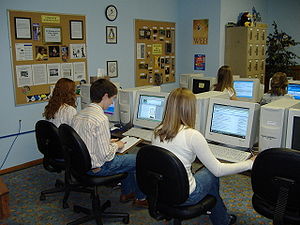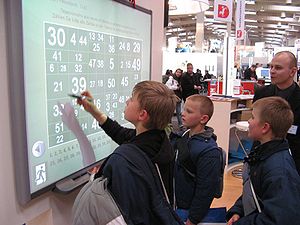- Computers in the classroom
-
Computers in the classroom include any digital technology used to supplement or replace a traditional teaching curriculum. As computers have become cheaper and more powerful, the demand for this technology has significantly increased, leading to longer use of computer resources within classes and a gradually decreasing ratio of students per computer in schools.[1] Academics continue to debate over the amount of significant educational value of the computer technology in schools provide.
Contents
History
Origins
College campuses have used computer mainframes in education throughout the development of computers since the early days of this technology the earliest known large scale study of educational computer usage, that 13% of the nation's public high schools used computers for instruction, though non-users still outnumbered users at a factor of 2 to 1. They also found that computers proved to be very popular with students, and activities used on these early models included sports statistic managers, administration tools, and physics simulators.[2] In 1975, Apple began donating Apple 1 models to schools, and mainframes began to lose their former dominance over academic research.[3] Computer usage continued to grow rapidly throughout this era. In 1977 it was estimated that over 90% of students at Dartmouth College had used computers sometime in their college careers. Walter Koetke, the director of a Lexington, Massachusetts school system commented that “It's still possible for a student to get through here without using the computer, but he would certainly have to try to do it”.[4]
Computer aided instruction gained widespread acceptance in schools by the early 80's, and it was during this period that drilling/practicing programs first developed for exclusive classroom use. Schools became divided over which computer manufacturers they were willing to support, with grade schools generally using Apple computers and high schools preferring DOS based machines. Hardware shortages in schools became a major issue, leaving many teachers unable to provide enough computers for students to use.[5] Despite this, by 1989 in the course of a decade computer usage has had increased from being a relative rarity in American public schools to being present in nearly every school district.[6]
Modern era
The early 90's marked the beginning of modern media technology such as CD-ROMs and the development of modern presentation software like Microsoft Powerpoint.[3] Other computer-based technology such as the electronic whiteboard[7] and laptop computer became widely available to students. In 1990, the Methodist Ladies College[disambiguation needed
 ] in Australia became the first campus to require every student to purchase a laptop. Governments around the world began to take notice of the effectiveness of this policy, and began financial initiatives to significantly increase the usage of laptop computers in other colleges as well.[5] In 1996, Bill Clinton made over $2 billion in grants available in the Technology Literacy Challenge Fund, a program which challenged schools to make computers engaging, connected, and available to every student. This marked a significant increase in demand for computing technology in many public school systems throughout the globe.
] in Australia became the first campus to require every student to purchase a laptop. Governments around the world began to take notice of the effectiveness of this policy, and began financial initiatives to significantly increase the usage of laptop computers in other colleges as well.[5] In 1996, Bill Clinton made over $2 billion in grants available in the Technology Literacy Challenge Fund, a program which challenged schools to make computers engaging, connected, and available to every student. This marked a significant increase in demand for computing technology in many public school systems throughout the globe.Correlating with the development of modern operating systems like Windows 98 and the continuing support of government funding, the prevalence of educational computer usage boomed during this period. Between 1997 and 1999, the ratio of students to multimedia computers decreased from 21 students per machine to less than 10. Collages began creating specialized classrooms designed around utilizing the most modern technology available. An example is the "Classroom 2000" built at Georgia Tech in 1999, which featured computers with audio and video equipment designed to capture detailed recordings of lectures as a replacement for traditional note taking.[8] By 2000, there were only 5 students per school computer in the US. More schools as a whole began to invest in powerful networks and ever faster Internet connections as collaborative classroom environments became mainstream. By 2010, many school districts have implemented or are encouraging “1:1 learning programs” which would insure that all students in grade school would be provided with a personal laptop.[9] In the future, computers are likely to significantly change current teaching methodology into a more "hands-on" approach, with Forbes predicting that "Instead of parking themselves in a lecture hall for hours, students will work in collaborative spaces, where future doctors, lawyers, business leaders, engineers, journalists and artists learn to integrate their different approaches to problem solving and innovate together."[10]
As with much technology that the moder era surrounds itself in, public school have never seemed to be caught up with the technology of its times.
References
- ^ Cuban, Larry (2001). Oversold and Underused: Computers in the Classroom. Cambridge, MA: Harvard University Press. p. 82. ISBN 064700602. http://books.google.com/books?id=sdSutyVQfzYC&printsec=frontcover&source=gbs_navlinks_s#v=onepage&q&f=false. Retrieved May 19, 2010.
- ^ United Press International (February 4, 1971). "Computers Employed as Teaching Aids". Reading Eagle. http://news.google.com/newspapers?id=8wUrAAAAIBAJ&sjid=HpgFAAAAIBAJ&pg=3260,1746468.
- ^ a b Murdock, Everett (2007). "History, the History of Computers, and the History of Computers in Education". http://www.csulb.edu/~murdock/histofcs.html. Retrieved May 19, 2010.
- ^ Haney, Daniel Q (August 28, 1977), "Computers in the classroom- no match for real live teacher", The Modesto Bee, http://news.google.com/newspapers?id=7YQ5AAAAIBAJ&sjid=k38FAAAAIBAJ&pg=972,4044700
- ^ a b Johnstone, Bob (2003). Never Mind the Laptops: Kids, Computers, and the Transformation of Learning. Lincoln, NE: iUniverse, Inc. pp. 1–8. ISBN 0595288421. http://books.google.com/books?id=BjY2fE8Od10C&printsec=frontcover&source=gbs_v2_summary_r&cad=0#v=onepage&q&f=false. Retrieved May 19, 2010.
- ^ Associated Press (August 28, 1989). "Most teachers think computers are boon to schools, poll says". The Deseret News. http://news.google.com/newspapers?id=CAwPAAAAIBAJ&sjid=TIQDAAAAIBAJ&pg=6776,5260983.
- ^ "Interactive Computer Whiteboards Create Winning Combination". Innovatis. October 2002. http://www.manningawards.ca/media/newsletter/pdf/october2002.pdf.
- ^ Suggs, Ernie (September 7, 1999). "Georgia Tech Harnesses Technology for Learning". The Tuscaloosa News. http://news.google.com/newspapers?id=hc8yAAAAIBAJ&sjid=A6YEAAAAIBAJ&pg=6769,1218958.
- ^ Brown, Jessamy; Jinkins, Shirley (February 25, 2010). "At tech-savvy DFW districts, netbooks are joining textbooks". Star Telegram. McClatchy Company. http://www.star-telegram.com/2010/02/24/1995392/technology-savvy-dfw-districts.html. Retrieved May 19, 2010.
- ^ Kembel, George (April 8, 2010). "The Classroom In 2020". Forbes.com. Forbes. http://www.forbes.com/2010/04/08/stanford-design-2020-technology-data-companies-10-education.html. Retrieved May 19, 2010.
Categories:- Educational technology
- Computing and society
Wikimedia Foundation. 2010.


